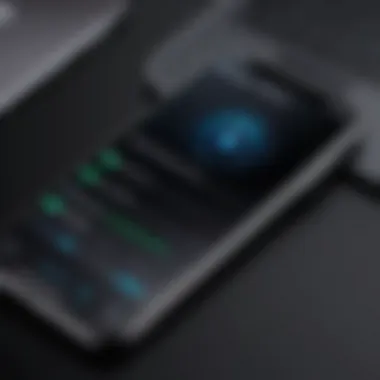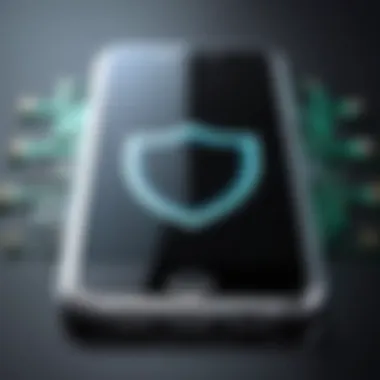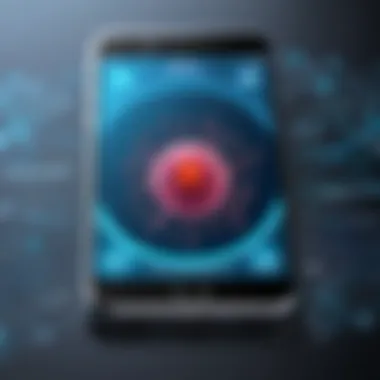Cost-Free Techniques to Eliminate Viruses from iPhones


Intro
Cybersecurity Threats and Trends
Notable cybersecurity threats in the digital landscape
As more services and applications shift online, new forms of cybersecurity threats continue to emerge. Ransomware, phishing scams, and malware infections all pose risks that can compromise personal and sensitive information. iPhones, without the suited vigilance, can fall victim to such threats. The shifts in user behavior, like sharing more online and using public Wi-Fi, increase vulnerability.
Emerging trends in cyber attacks and vulnerabilities
With evolving technology, cyber attackers continually find novel tactics. For instance, recent trends show attacks targeting mobile applications and new vulnerabilities in operating systems. Hackers exploit weaknesses, often aiming for apps where users may store financial or sensitive information. iOS devices aren’t immune; thus, awareness and a proactive stance are key.
Impact of cyber threats on individuals and businesses
The implications of these cyber threats extend beyond inconvenience. They can affect individuals through compromised personal information or financial loss. For businesses, a breach could tarnish reputations, disrupt operations, and lead to significant financial penalties. Protecting your iPhone captures not just individual safety but broader community trust and safety.
Best Practices for Cybersecurity
Importance of strong password management
A weak password can act as an open door for cybercriminals. It's imperative to use complex passwords combining letters, numbers, and symbols. Change passwords regularly and avoid reusing them across multiple platforms.
Remember, a strong password is your first line of defense against unauthorized access.
Implementing multi-factor authentication for enhanced security
Multi-factor authentication (MFA) adds another layer of security. By requiring additional verification, like a code sent via SMS or email, it safeguards your account. This step greatly reduces the chances of unauthorized access.
Regular software updates and patches for protection
Apple frequently releases software updates that patch vulnerabilities. Keeping your iPhone updated ensures you benefit from these security fixes, helping shield your device from potential threats.
Secure online browsing habits and email practices
Be mindful of where and how you enter personal information online. Avoid clicking on suspicious links or downloading untrusted attachments. Many cybersecurity issues start with deceptive emails or unsafe websites, so careful habits are essential.
Privacy and Data Protection
Importance of data encryption for privacy
Data encryption ensures that, even if your data gets compromised, it remains unreadable without the proper key. Apple boasts strong encryption protocols, which help keep your private information secure.
Risks associated with sharing personal information online
Think twice before sharing details online. Posting things like your location, phone number, or financial information can draw unwanted attention from attackers. The internet is public; maintaining a cautious approach is crucial.
Strategies for safeguarding sensitive data and personal details
- Use iOS's built-in features to restrict app permissions.
- Regularly check and manage what data apps can access.
- Always log out of accounts when using shared devices or public systems.
Security Technologies and Tools
Overview of key cybersecurity tools and software
While you can take many steps manually, various tools can assist with your iPhone's security. Antivirus applications, although often paid, can offer free versions with basic functionality, providing an extra layer of protection against malware.
Benefits of using antivirus programs and firewalls
Having antivirus software helps detect and neutralize threats before they can cause harm. Firewalls can help prevent unauthorized access, adding another protection layer in your device’s security fabric.
Application of Virtual Private Networks (VPNs) for secure data transmission
When browsing on public networks, using a VPN encrypts your data, making it difficult for hackers to intercept your communication. It disguises your IP address, offering an additional level of anonymity and safety.
Cybersecurity Awareness and Education
Educating individuals on recognizing phishing attempts
One of the most critical skills in today’s digital age is the ability to identify phishing attempts. People often overlook subtle signs, such as inconsistent email addresses or unusual requests. Training oneself to spot these red flags is paramount.


Promoting cybersecurity awareness in the digital age
Awareness campaigns help inform and educate. Sharing knowledge and techniques with friends and family fosters a community approach to cybersecurity, amplifying your protective efforts.
Resources for learning about cybersecurity fundamentals
There are numerous online resources to deepen your understanding:
- Wikipedia for foundational concepts.
- Britannica that offers detailed articles.
- Communities like Reddit can provide real-world insights and experiences.
As we conclude this segment on removing viruses from your iPhone, the paramount message is to exercise diligence. While these strategies serve as a roadmap, staying informed and vigilant in an ever-changing digital landscape is vital.
Understanding iPhone Security
When it comes to our daily lives, few devices are as integrated and essential as our smartphones, particularly the iPhone. The convenience provided by these devices also comes with a big responsibility: understanding how to protect them from potential threats, such as viruses. Knowing about iPhone security isn’t just about addressing the immediate consequences of a virus; it’s about elevating your awareness and preparedness. Many people tend to underestimate the value of mobile security, but the truth is, being proactive can save you a lot of headaches down the road.
Understanding iPhone security starts by getting comfortable with several fundamental aspects. For one, the operating system, iOS, has built-in security features intended to keep devices secure. However, considering the frequency and sophisticated nature of cyber threats today, relying solely on these built-in measures isn’t enough. Instead, users must take additional steps to enhance their security posture. Knowing what you can do—and how you can do it—can make a world of difference.
The Importance of Mobile Security
Mobile security is crucial as smartphones like the iPhone are often viewed as treasure troves of personal data.
From banking apps to sensitive emails, our phones store a wealth of information that's ripe for the picking if proper precautions aren’t taken. A breach of such sensitive information can lead to identity theft or financial loss. Notably, the importance of mobile security lies in the balance between convenience and safety. Users must navigate this landscape wisely.
In addition to personal data, malware can also hijack your phone's functions, leading to unforeseen consequences. The ability to react quickly in case of a suspected virus infection can be the difference between saving or losing important data. Additionally, smartphone security is not just about protection; it's also about building a habit of vigilance. Just like you’d check the locks on your doors at night, you should regularly assess your phone's security.
Common Myths About iPhones and Viruses
Myth 1: iPhones are immune to viruses.
Many users operate under the misconception that iPhones are impervious to viruses and malware. While it’s true that the iOS environment is comparatively secure, claiming absolute immunity is risky. Just like any other system, vulnerabilities can exist, and cyber attackers are constantly innovating in their methods.
Myth 2: Only jailbroken iPhones get infected.
Some believe that only those who jailbreak their devices are at risk of virus infections. While jailbreaking certainly opens up vulnerabilities, stock iPhones aren't off the hook. Even standard configurations can be susceptible to various forms of malware, especially if apps from unverified sources are downloaded.
Myth 3: Antivirus apps are unnecessary.
It's a common belief that antivirus solutions are not essential for iPhones. Although the iOS system comes with significant security features, using additional security apps can add an extra layer of protection. Think of it as wearing a helmet while riding your bike; it’s not just about following the rules; sometimes, precautions save lives.
It's vital to break through these myths and critically evaluate your own habits. Smartphones require just as much attention to security as any computer. The more you understand these elements and acknowledge the realities of mobile security, the better prepared you will be to keep your device—and your information—safe.
Identifying Signs of Virus Infection
When it comes to dealing with viruses on your iPhone, the first step is recognizing that an issue even exists. The importance of identifying signs of virus infection cannot be overstated. A keen eye can save you headaches and ensure you take action before things spiral out of hand. Knowing what symptoms to look for is like having a roadmap that guides you through potential threats, allowing for timely intervention. Ignoring these signs could lead to degraded performance, privacy breaches, and even data loss, which nobody wants.
Unusual Behavior of Apps
Imagine, you’re scrolling through your apps, and one of them starts acting like it’s auditioning for a bad sci-fi movie. Maybe it opens by itself, crashes without warning, or frequently misbehaves. This unusual behavior is a classic red flag that something may not be right. Sometimes, apps can become buggy due to updates, but persistent erratic behavior could indicate a hidden virus.
If you notice that an app you use daily has suddenly switched gears—like resetting itself, prompting for permissions that seem over the top, or becoming unresponsive—it’s worth investigating. Ensure that you keep your apps updated and only download them from trusted sources like the Apple App Store. Apps with bad reviews or low ratings can often be breeding grounds for malware.
Unexpected Pop-ups and Ads
Another sign of a potential virus lurking in your iPhone is the appearance of unexpected pop-ups or intrusive advertisements. You know the drill: you’re browsing a website, and suddenly, a flood of pop-ups descends, leaving you scrambling to close them all. Legitimate sites do their best to keep these annoying ads at bay; if you’re encountering them excessively, something is amiss.
Often, these pop-ups can redirect you to dubious websites that can potentially harm your device or steal your personal information. It’s not just a nuisance; it’s a warning sign! If you find yourself bombarded with ads that seem to pop up out of nowhere or direct you to unfamiliar sites, consider it a wake-up call to check for malicious software.
Battery Drain and Performance Issues
Lastly, perhaps one of the more telling signs of a virus on your iPhone is sudden battery drain and general performance woes. If your iPhone’s battery is draining faster than you can charge it, there’s a chance that a hidden virus is behind the scenes, working tirelessly to compromise your device’s functionality.
You might also experience slow response times, freezing screens, or long loading times for simple tasks. These performance issues could be attributed to rogue processes running due to a virus. Keep an eye out. Check your battery settings to see if any app is consuming an abnormal amount of power. If it’s not the usual suspects—apps you actively use—it may suggest something more sinister at work.
"Identifying the signs early is key. Your iPhone should feel snappy, responsive, and reliable. If it doesn't, act fast."
By being mindful of these signs, you can spot potential virus infections early and take appropriate action to protect your device and personal data.
Free Methods to Remove Viruses from Your iPhone
Removing viruses from your iPhone without spending any money is not just a cost-effective approach; it’s practically essential in today’s digital world. As our phones become an integral part of our lives, understanding free methods for virus removal empowers users to maintain their device's integrity without the need to rush to professional services. This section dives into various strategies that are entirely free, ensuring that users can confidently tackle any virus issues that may arise without putting a dent in their wallet.
Manual App Deletion
When dealing with unwanted apps that might be harboring viruses, manual app deletion is one of the first steps to consider. It’s straightforward and requires no technical knowledge. Just follow these simple steps:
- Unlock your iPhone and navigate to the home screen.
- Locate any suspicious apps. If you've downloaded something recently and it seems dubious, that’s a red flag.
- Press and hold the app icon until a menu pops up or the icons start to jiggle.
- Tap the small ‘X’ in the corner of the app you wish to delete. Confirm when prompted.
This method not only removes the potential threat but also declutters your device, which can improve overall performance.


Using Settings to Clear Browsing Data
Web browsing can be a double-edged sword. While it opens up a world of information, it can also expose you to malicious sites and unwanted ads. Clearing your browsing data can help get rid of those pesky threat remnants:
- Open the Settings app.
- Scroll down and tap on Safari (or whichever browser you use).
- Find Clear History and Website Data. Select it. Confirm the action.
By clearing your browsing data, you eliminate cookies and trackers that might be causing issues or opening doors for malware on your device.
Resetting Network Settings
If you find that your iPhone is running slow or apps are behaving oddly, consider resetting your network settings. This action does not delete your data, but any saved Wi-Fi passwords will be wiped out. To do this:
- Go to Settings > General.
- Scroll down to Reset and select Reset Network Settings.
- Confirm your decision. Your iPhone will reboot, and all network-related settings will be restored to factory defaults.
This could help stop the virus from using your network and improve connection stability as well.
Restoring Your iPhone via iTunes
If other methods haven't cut the mustard and you suspect more serious issues, restoring your iPhone using iTunes could be your last resort. This method wipes your device and reinstalls iOS, effectively removing all data, including viruses. To do this:
- Backup your iPhone first! Use iCloud or iTunes to save critical data.
- Connect your iPhone to your computer using a USB cable.
- Open iTunes. Select your iPhone when it appears on the screen.
- Click on Restore iPhone. Follow the prompts to erase your device and reinstall iOS.
This process should be approached with caution; it’s not just a virus fix but a full reset, meaning any unsaved and unbacked data will be lost.
"Restoration can be a fresh start, but always ensure your data is protected."
These free methods provide a range of options for users, from minor adjustments to complete resets, ensuring that iPhone owners can tackle potential virus issues effectively and affordably.
Utilizing Free Security Apps
In a world where cyber threats loom large, utilizing free security apps can be an effective way to safeguard your iPhone from viruses and malware. While it’s essential to be wary of the implications of downloading apps, many free antivirus options can enhance your defenses without burning a hole in your pocket. Understanding the significance of these tools is crucial, especially for those who might rely heavily on free resources for their digital security.
Review of Free Antivirus Solutions
When exploring the myriad of free antivirus solutions available, it’s important to recognize that not all apps are created equal. Some might have limited features, while others might offer comprehensive protection tailored for iOS systems. Popular selections like Avast Security & Privacy and Malwarebytes offer robust scanning capabilities and real-time protection without charging a dime. Users should look for apps that include:
- Real-Time Scanning: This allows the app to continuously monitor activities on your device for suspicious behavior.
- Privacy Protection: Some apps help safeguard personal information by identifying potential risks like data breaches.
- Web Protection: Many antivirus solutions include features that alert users to phishing sites or unsafe downloads, proving essential for browsing securely.
All in all, checking reviews on platforms like Reddit and examining functionality through credible tech blogs can aid in making an informed choice.
How to Choose a Reliable App
Choosing the right free security app involves more than just a quick download. Here are some considerations to keep in mind:
- Reputation and Reviews: Always research the developer’s background. Well-known names have often built trust over the years. Reading user reviews on forums like Facebook can give insights into real-world performance.
- Feature Set: A good antivirus app should have a diverse feature set. Look for essential services like malware scanning, privacy scanning, and web filtering. Avoid those with redundant features that muddy the waters.
- Updates and Support: Ensure that the app receives regular updates since new threats emerge daily. An app that quickly adapts to the changing landscape is better equipped to protect your device.
- User Interface: A straightforward, intuitive interface resonates well with most users. If it feels like deciphering a complex puzzle just to use the app, you may want to reconsider.
- Transparency: It’s helpful if the app respects user privacy and clearly states what data it collects. Trust your gut; if something seems off, look for alternatives.
Reliable security is not just about having tools; it’s about knowing how to use them wisely.
When to Seek Professional Help
The digital world is, to put it mildly, a wilderness filled with threats. Sometimes, even with all your efforts to safeguard your device, you might still find yourself in a pickle. Understanding when to seek professional assistance for your iPhone can save you a whole lot of trouble and possibly significant loss of data. So let’s dive into why this is crucial and what to look out for.
Identifying Serious Threats
Recognizing when a threat is severe enough to warrant professional input is half the battle. Here are a few indicators that suggest it might be time to call in the experts:
- Persistent Malware Symptoms: If you notice ongoing issues like battery drain, frequent crashes, or unexplained data usage even after you’ve tried to remove the virus, it’s a red flag. Stubborn malware can embed itself deeply, making user-level fixes ineffective.
- Suspicious Activity: If your iPhone begins automatically making calls, sending messages, or your personal data appears compromised—like sudden password changes—then you’ve got more than just a minor inconvenience. These are serious signs of a potential security breach.
- Network Anomalies: If your internet connection shows weird patterns or you notice your data plan dwindle at alarming rates, the likelihood of a deeper issue rises. A professional can scrutinize your device’s connections to diagnose any lurking threats.
It's often better to act early than to wait until a minor issue escalates into a full-blown crisis.
Choosing the Right Service Provider
When you've made the decision to seek professional help, how do you choose the right service provider? It's not just about picking someone who looks nice on the surface; there's a method to this madness.
Licensing and Credentials
Licensing and credentials are the bedrock of trust when choosing a service provider. Here’s why that matters:
- Assurance of Expertise: A licensed technician demonstrates they’ve completed the necessary training. Not just anyone can claim they know about iPhones. Their credentials show they've put in the hours to understand the nitty-gritty of such devices.
- Credibility: Providers with recognized credentials often follow industry standards. This adherence to best practices makes them a safer choice when entrusting them with your personal device.


If a provider can’t show evidence of credentials, it’s a sign for a hard pass.
- Unique Features: The beauty of licensing isn’t just in formality; it often comes with guarantees. Should mishaps happen, licensed providers usually have insurance or recourse for their errors. For example, if a device is further damaged during a repair by an unlicensed technician, there's usually little to no liability.
Customer Reviews and Feedback
Customer feedback can sometimes paint a picture as clear as day when deciding on a provider. Here’s how:
- Real-World Experience: Customers’ experiences can reveal heaps about a service provider’s reliability. Positive reviews highlight trustworthy services, while consistent negative feedback shouts caution.
- Benefit of Transparency: Most modern customers are more than willing to share their thoughts online, whether on forums like Reddit or larger platforms like Facebook. It’s a trove of information that can guide your decision-making process.
- Unique Features: Keep an eye on the kind of problems that customers highlight in their reviews. Are they common issues that can strike fear into any user, or are they minor niggles? If serious concerns like fraud or data leaks frequently pop up in reviews, you probably don’t want to take the risk.
And always remember to look out for a pattern in both ratings and comments. One or two bad reviews can happen to any business, but a slew should send you packing in the opposite direction.
In summary, when faced with a serious threat, knowing when to get help and discerning the right provider could make all the difference. It's not just about getting your device fixed, but ensuring your data and personal security remain uncompromised.
Preventive Measures to Ensure Device Safety
When it comes to keeping your iPhone safe from viruses, prevention is key. Many users think that once a problem arises, they can just deal with it. However, a stitch in time saves nine. By implementing preventative measures, you minimize the risk of infections in the first place. This saves you the hassle of dealing with potential damage to your device and protects your personal data, which could be the real gold mine for malicious actors.
Regularly Update Your iOS
One of the simplest yet most effective steps you can take is to keep your iPhone’s iOS up to date. These updates often include important security patches that address vulnerabilities, which hackers might exploit. Missing out on these updates is like leaving your front door wide open, inviting trouble.
To check for updates, go to Settings > General > Software Update. If an update is available, install it right away. Not only do updates fortify your device's defenses, but they also introduce enhancements that improve performance and usability. So, keep your iOS in tip-top shape—your future self will thank you.
Recognizing and Avoiding Phishing Attempts
Now, you might have heard that a scammer's favorite tool is deception. Phishing attempts can take many forms, such as deceptive emails, text messages, or even fake websites that look oddly familiar. The goal is to trick you into giving away your information, such as passwords or credit card numbers. Recognizing these attempts can often feel like trying to find a needle in a haystack, especially for those untrained in cybersecurity.
Here are some key points to keep in mind:
- Examine the Source: Always take a second glance at the sender’s email address or the URL of the website. Think twice if something feels off.
- Look for Red Flags: Misspellings, awkward phrases, or requests for personal information are telltale signs of a phishing attempt.
- Think Before You Click: A legitimate organization will never ask for sensitive information via email or text. If you're unsure, contact the organization directly through official channels.
These proactive steps can go a long way in safeguarding your personal data and your phone from being compromised.
The Role of Two-factor Authentication
Two-factor authentication (2FA) is a robust line of defense that adds an extra layer of security to your accounts. Simply put, it requires not only your password but also a second piece of information—often a code sent to your phone or generated by an app. This essentially acts like a double lock on your front door.
Setting up 2FA is not only wise but also remarkably straightforward. Many services, including email providers and social networks, offer this feature. Here’s how you can go about it:
- Navigate to Account Settings: Go into your account settings on the respective application.
- Enable Two-factor Authentication: Look for security settings, then select the option to enable 2FA.
- Choose Your Method: Decide whether you want to receive the code via SMS, an authentication app, or email.
Remember, even if someone knows your password, they can’t access your account without that second factor.
Implementing 2FA significantly lowers the chances of unauthorized access to your accounts and, by extension, the security of your iPhone.
Through these proactive measures—updating your iOS, recognizing phishing attempts, and employing two-factor authentication—you can ensure far greater safety for your device. Ignoring these can mean opening a can of worms that you'd rather keep shut.
Finale and Summary Insights
In wrapping up our exploration of effective ways to remove viruses from your iPhone without any financial outlay, it's crucial to underscore a few key points. The digital world we inhabit is rife with threats, and mobile devices, especially iPhones, have become prime targets. Users must equip themselves with the knowledge and skills to safeguard their devices. This article has delved into not just how to address virus issues once they appear, but also into preventive measures, which are equally, if not more, important.
Being proactive can save a user a lot of headaches. Updates to your iOS system, keeping an eye out for phishing attempts, and enabling two-factor authentication all play a vital role in maintaining the integrity of your device. The consequences of ignoring these factors can range from data loss to identity theft, underscoring the significance of vigilance in today's interconnected society.
"An ounce of prevention is worth a pound of cure."
This saying truly resonates in the context of mobile security. By incorporating the discussed strategies into your routine, you cultivate a safer digital environment for yourself.
Ultimately, understanding the signs of a virus infection can empower users to act quickly and avoid further complications. The tools at your disposal, many of which are free, can work wonders if utilized effectively. Completing the loop back to initial awareness ensures users are equipped not just for current threats but also ready to adapt to future challenges.
Recap of Key Strategies
To succinctly recap, several strategies emerge as essential:
- Manual App Deletion: It's vital to manage applications on your device. Regularly check for unfamiliar or suspicious apps, and don't hesitate to remove them.
- Clear Browsing Data: Frequently clearing your browsing history and data can help eliminate many vulnerabilities that malware exploits.
- Reset Network Settings: This often-overlooked step can resolve many connectivity issues that may be related to malware.
- Using Free Security Apps: Research and select trustworthy antivirus solutions available at no charge. These can help detect and eliminate threats.
- Seek Professional Help: If the signs point to a serious compromise, reaching out to professionals can mitigate sustained damage.
By familiarizing yourself with these strategies, you can better maintain your iPhone's health, ensuring it remains a tool for productivity and connection.
Looking Ahead: The Future of Mobile Security
As we look to the horizon, mobile security will surely evolve in response to the ever-changing landscape of cyber threats. New malware and persistent styles of attacks will emerge, requiring users to stay informed.
Anticipating advancements in technology can provide insight into potential security risks. For instance, as machine learning and AI become more integrated into cybersecurity efforts, we will likely see a mix of prevention mechanisms that are more sophisticated than today’s offerings. Additionally, the growing reliance on cloud services raises new privacy concerns and necessitates tighter security protocols.
It's also critical to recognize that users themselves will be at the forefront of mobile security. This means ethical awareness about personal data sharing, avoiding risky downloads, and recognizing the importance of strong passwords.
In summary, the future could hold promise for improved mobile security. However, it hinges on informed users who prioritize their device's safety. Continuous education and adaptation in security practices will be the bedrock of secure mobile usage moving forward.







